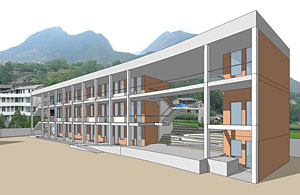Amid the wreckage of China’s massive earthquake last May, the sight of collapsed school buildings served as a powerful symbol of the depth of the tragedy. As architects and engineers ponder how to improve rural building safety, a new program is bringing together local people, young architects, and experienced designers to build a set of new schools that offer more than just safe construction.

The Dangpu school features an outdoor assembly area.
“This is a big historical opportunity to reconsider many things, like what is the role played by education in our society,” says Zhu Tao, an architect who is one of the organizers of the program, Re-tumu, which focuses on the design and construction of new schools in Gansu and Sichuan provinces. Inspired in part by Taiwan’s New School Movement, which began after a devastating earthquake there in 1999, Re-tumu envisions reconstruction as a cultural project. “It’s not just a hardware repair but a software update,” says Zhu.
When architects paid visits to affected villages in the months after the earthquake, they saw flimsy temporary buildings and unseemly conditions. “It was so hot inside one school that one girl passed out every 20 minutes,” says Zhu. To understand the needs of the communities for whom they were building, architects consulted with local residents, parents and children, while school principals and officials from the villages sat on juries that chose the designs of some of the new schools.
As one of its first initiatives, Re-tumu invited Japanese architect Shigeru Ban to design a temporary school in Hualin, Sichuan, using the same kind of paper-tube construction he pioneered in 1995 after an earthquake ruined much of Kobe, Japan. Ban’s school, which will be used for at least three years, was not cheap or easy to build. But it has raised the profile of earthquake rebuilding projects, provided experience for the Chinese and Japanese architects who volunteered to help with construction, and become a place of pride for the community. “If you’re a resident, all these temporary constructions, banfang, they’re always reminding you you’re living in a disaster zone,” says Tao. After Ban’s school opened, “the children were hanging gleefully on the columns like monkeys.”
Architects working on permanent schools are also making their designs sensitive to the local climate and community. For example, Zhu and Shuqing Cecilia Li of ZL Architecture designed an elementary school for Dangpu, using an elongated 3-story steel-framed building with ample sunlight and ventilation. Breaking with traditional school design, the architects punched a large opening on one end of the building to create an open-air assembly space and widened corridors to facilitate after-class activity.
For an elementary school in Lijiaping, the program brought in architect Yu Jia, while Liu Xiaodu of Urbanus was hired to design the Weizigou Elementary School. A competition to find young architects to design four additional schools ended up selecting Gong Weimin Studio from Shenzhen (to design Chengguan First Elementary School), Yu Liu and Lan Xia from Shenzhen (Dongyukou Elementary), Lu Wang of In+of Architecture from Beijing (Hananzhai Elementary), and Benmo Architecture from Ningbo (Liujiaping Elementary).
Set to be completed in May, the new schools still face many hurdles. Publicity has been scarce because the topic of post-earthquake school rebuilding is still taboo for even Guangzhou’s most progressive newspapers. Meanwhile, reliable charity sponsors have been hard to find, while organizers scramble to cope with bureaucracies, the possibility of corruption, and cost-cutting during construction. For Zhu, the program is not just a test of China’s young architects in disaster situations, but a chance to push the country’s nongovernmental organizations in new directions. “We’re trying hard to squeeze a space out of the rigid social structure. And we’re learning a lot by trying.”



Post a comment to this article
Report Abusive Comment